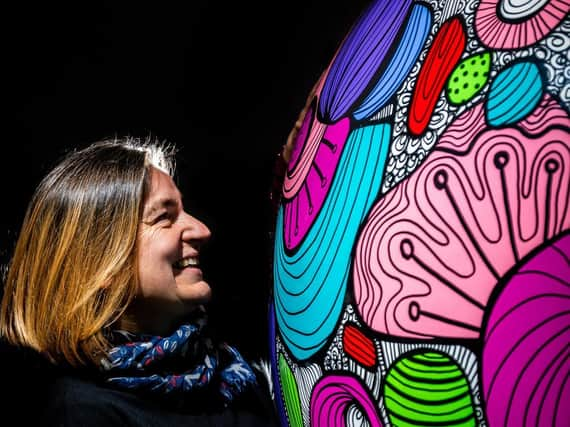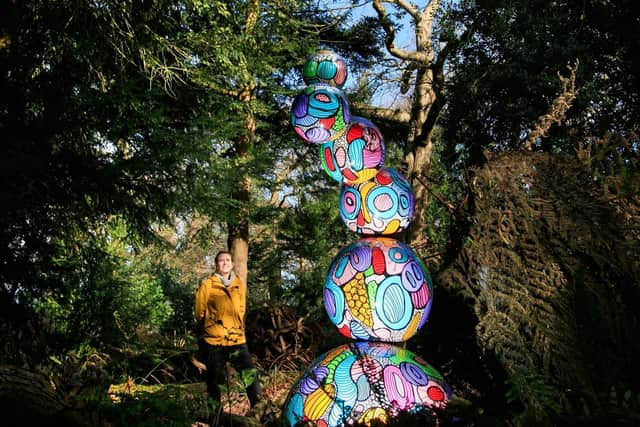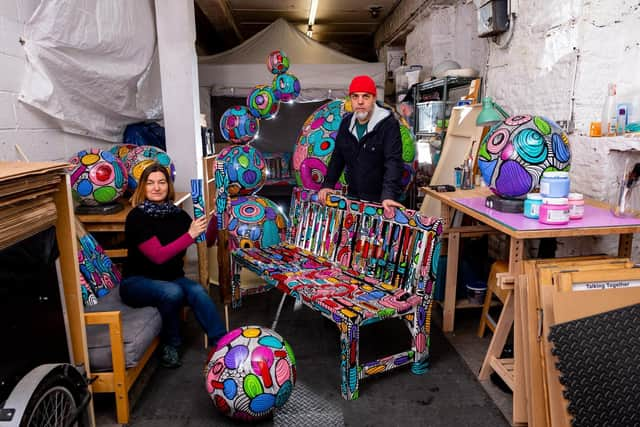Meet Lenny and Whale the artists inspired by an 18th century pioneer and two pandemics 300 years apart


And while the names Lenny and Whale might not be as recognisable as these art world heavyweights, their work is no less colourful or thought provoking, as their latest art installation which was recently unveiled at Wentworth Castle Gardens, near Barnsley, proves.
Lenny and Whale are Yorkshire collaborators Paul Slater and Katrina Whale (Paul has worked under the name Fabric Lenny for 25 years) and their vibrant new installation – Colour Forms – straws upon the water – is inspired by a woman who you probably haven’t have heard of, but who 300 years ago helped pioneer the use of vaccines.
Advertisement
Hide AdAdvertisement
Hide AdIt was Lady Mary Wortley Montagu who brought the concept of the smallpox inoculation to England from Turkey in 1721, after seeing women infecting people with a small amount of the disease, to build immunity, a practice common in the Islamic world but virtually unknown in the West.


She had seen first hand the devastating impact of smallpox having lost her brother to the disease. She was later struck down with it and although she survived was left with badly scarred skin.
As well as being one of the deadliest diseases in history, smallpox is also the only human disease to have been eradicated by vaccination.
The major breakthrough came several decades later when Edward Jenner discovered a safer way to protect people against it using the less harmful cowpox.
Advertisement
Hide AdAdvertisement
Hide AdThe Sun Monument, an obelisk in Wentworth Castle Gardens, was dedicated to Lady Mary by William Wentworth, whose father Thomas Wentworth built the Wentworth Castle estate.


William and his three sisters were some of the first children in England to be inoculated against smallpox, after Lady Mary, who married Edward Wortley Montagu, who came from nearby Wortley Hall, made it fashionable amongst high society circles.
Paul and Katrina were commissioned to create an artwork (part of an Artists in Residence project to explore the stories of Wentworth Castle Gardens) and when they started on the project in February last year, the world was only just waking up to the scale of the coronavirus outbreak.
“When we first visited we were struck by the story of Lady Mary and as the project developed it was striking to discover how this early medical intervention resonated with the current research being undertaken in the development of vaccines for Covid,” says Paul.
Advertisement
Hide AdAdvertisement
Hide AdThe subtitle of their finished piece, ‘straws upon the water’, is taken from a quote attributed to Lady Mary, who said: “I am afraid we are little better than straws upon the water; we may flatter ourselves that we swim, when the current carries us along.”
This, too, resonated with the artists. “It sums up the fragility of the human condition and it was another parallel between the past and the present,” adds Paul.
The pair studied the shapes and colours of virus imagery, and worked with families from Silkstone Primary School to develop concepts for the artwork, using Paul’s studio in Holmfirth as a base.
“We looked at microscopic images of viruses and the patterns they make and the patterns that are made throughout nature, everything from molecular forms right up to leaf formations.” They also took inspiration from the Sun Monument, which is believed to be the oldest monument in the country dedicated to a non-royal woman.
Advertisement
Hide AdAdvertisement
Hide Ad“A lot of National Trust properties and stately homes have statues that celebrate men on plinths and this was an opportunity to celebrate the story of a woman who has been overlooked,” says Paul.
The artwork, which consists of a series of hand painted spheres, a molecular structure and two benches is accompanied by a specially composed soundscape, and though two deadly pandemics shaped the creative process, the artists were keen to create something uplifting. “We wanted to make something celebratory and colourful, we didn’t want to dwell on the pandemic,” says Katrina.
The pair began their artistic partnership just over a year ago. Katrina was born and raised in Leeds and trained as a dancer teacher and has worked in community arts for the past 20 years.
Paul comes from Ossett originally and has been a freelance artist for more than 25 years, with a background in fine art and printmaking as well as everything from digital art to animation.
Advertisement
Hide AdAdvertisement
Hide Ad“Our paths have crossed over the past ten years where we worked separately as artists on projects and then last year we kind of formed a creative partnership,” says Katrina.
They are both interested in public art and the idea of reaching as broad an audience as possible. “Lots of people think that art in general isn’t for them and we want to make work that is accessible, beautiful and fun. Something that people can engage with without thinking they need to read a textbook before they can appreciate it,” says Paul.
He feels that a growing number of artists are experimenting and collaborating. “I feel there is more interesting work going on and certainly over the last ten years I’ve seen a lot more impressive, often small scale, pieces of work in the public realm.
And not just sculptural, sometimes it’s sound-based or projection-based and I think the public has become more accustomed to seeing it and people are embracing it more.”
Advertisement
Hide AdAdvertisement
Hide AdPaul and Katrina are keen to explore the different ways that art can change our perception of what a particular space can be used for.
“The piece at Wentworth Castle Gardens is an experiment because we didn’t know how the vibrant colours would work in that muted green and brown space. But what’s been interesting as flowers have started to emerge is that the space around the work is changing.”
Following its stint in the Fernery at Wentworth Castle Gardens, the artwork will go on a mini-tour moving to Cannon Hall Gardens in the middle of this month and then Elsecar Heritage Centre in May.
“We enjoyed working in an outdoor environment so we’d definitely like to do more of this, taking art to unexpected places where people stumble upon it rather than it being in more formal spaces,” says Katrina.
Advertisement
Hide AdAdvertisement
Hide AdThey have a couple of other projects on the go, including a four-metre reclining troll for an outdoor space in Rotherham, and Routed, in Barnsley, which celebrates stories from the town that will feature in an exhibition later his year.
“We’ve both collaborated with other artists and we feel that we complement each other’s work,” says Paul. “I think ideas are more interesting when you work in collaboration because you’ll come up with things you wouldn’t necessarily have come up with on your own. It’s been great and we’re really pleased with the work.”
They hope those who encounter it will be, too. “If people stop and pause and appreciate the environment when they see our work then that would be great, and if it raises a smile as well then that’s even better... Job done.”
Wentworth Castle Gardens is open to visit for people living locally and must be pre-booked online via www.nationaltrust.org.uk/wentworth-castle-gardens